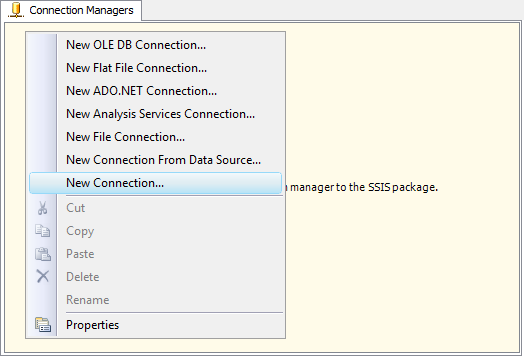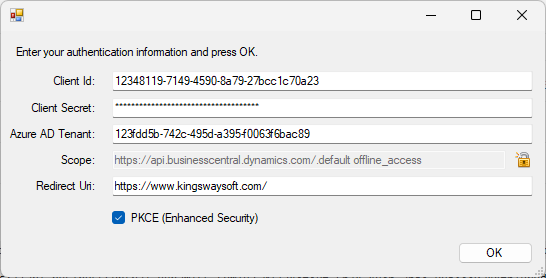Using the BC/NAV Connection Manager
BC/NAV Connection Manager is an SSIS connection manager that can be used to establish connections with a Microsoft Dynamics 365 Business Central or Microsoft Dynamics NAV Server. For the purpose of this documentation, Microsoft Dynamics 365 BC/NAV will refer to both Microsoft Dynamics 365 Business Central and Microsoft Dynamics NAV.
The BC/NAV Connection Manager allows you to specify how you want to connect to your Microsoft Dynamics 365 BC/NAV server.
To add a BC/NAV connection to your SSIS package, right-click in the Connection Manager area, and choose "New Connection..." from the context menu.

You will be prompted the "Add SSIS Connection Manager" window where you can select the "DynamicsNAV" item to add.

The BC/NAV Connection Manager contains the following three pages which configure how you want to connect to the Microsoft Dynamics BC 365/NAV server:
- General
- Advanced Settings
- More Info
General Page
The General page on the BC/NAV Connection Manager allows you to specify general settings for the connection.
- Server and Login Details
-
- Service Endpoint
-
The Service Endpoint option allows you to specify the service endpoint that you want to use in order to connect to the Microsoft Dynamics BC/NAV server. We currently support the following options:
- OData (Dynamics 365 Business Central, Dynamics NAV Server 2018 or above)

-
- SOAP (Dynamics 365 Business Central and all versions of Dynamics NAV Server)


- OData (Dynamics 365 Business Central, Dynamics NAV Server 2018 or above)
-
- REST (Dynamics 365 Business Central)

- REST (Dynamics 365 Business Central)
- Server Version
-
The Server Version field lets you choose the version of Dynamics 365 BC/NAV that you are running. There are currently fourteen options:
- Dynamics 365 Business Central Online
- Business Central 2021 Release Wave 2 (v19)
- Business Central 2021 Release Wave 1 (v18)
- Business Central 2020 Release Wave 2 (v17)
- Business Central 2020 Release Wave 1 (v16)
- Business Central 2019 Release Wave 2 (v15)
- Business Central April 2019 Release (v14)
- Business Central October 2018 Release (v13)
- Business Central April 2018 Release (v12)
- Dynamics NAV 2018
- Dynamics NAV 2017
- Dynamics NAV 2016
- Dynamics NAV 2015
- Dynamics NAV 2013 R2 or 2013
- Dynamics NAV 2009 R2 or 2009
- Authentication Type
-
The Authentication Type field lets you choose the preferred authentication method to connect to a NAV or a Dynamics 365 Business Central Online instance. 'Basic' Authentication type will be automatically selected for all NAV versions while for Dynamics 365 Business Central Online, you can choose between Basic and OAuth authentication types.
- NAV Server
-
The NAV Server field lets you specify the location of your Dynamics NAV web service. This option is only available when connecting to a Dynamics NAV Server.
- Service URL
-
The Service URL will be automatically populated based on the NAV Server specified as discussed above. Using the Service URL option, you can provide an alternative NAV web service URL which you might have set up in a way that's different from the default.
For connecting to Dynamics 365 Business Central Online, the Service URL may not be populated for you initially. You need to provide an URL in the correct format depending on whether you are using SOAP or OData Service Point for connecting to the service.
The Service URL should be in the following format:- Dynamics 365 Business Central Online (SOAP): https://api.businesscentral.dynamics.com/v2.0/<AzureTenantId>/WS
- Dynamics 365 Business Central Online (OData): https://api.businesscentral.dynamics.com/v2.0/<AzureTenantID>/Production/ODataV4
- NAV On-Premises: http://<NavServerName>:port/InstanceName/WS
-
You also need to make sure to replace <AzureTenentID> with the real Azure Tenant ID of your organization.
- User Name
-
The User Name option allows you to specify the user account that you want to use to connect to your 365 BC/NAV system. Depending on how the NAV connection is used, the user account needs to have proper privileges in your NAV system.
Note: For Dynamics 365 Business Central, the User Name can be found on the User page. You would need to use the username listed under the USER NAME column, ex: ADMIN, in the NAV Connection Manager.
- Password
-
The Password option allows you to specify the password for the above user account in order to log in to your 365/NAV server.
The Dynamics 365 Business Central Web Service Access Key would be the password for your Dynamics 365 Business Central user account. Simply click on the AssistEdit button to generate or update your Web Service Access Key.

Note: The Password is not included in the NAV connection manager's ConnectionString property by default. This is done by design for security reasons. However, you can include it in your ConnectionString if you want to parameterize your connection manager. The format would be Password=myPassword; (make sure you have a semicolon as the last character). It can be anywhere in the ConnectionString.
- Token Path (only available when working with OAuth Authentication Type)
-
The path to the token file on the file system.
- Get New Token (only available when working OAuth Authentication Type)
-
This button allows you to log in to the service endpoint and authorizes your app to generate a new token.

- Client Id: The Client Id option allows you to specify the ID (in GUID format) of the Azure Active Directory (Azure AD or AAD) application you have created for application authentication.
- Client Secret: The Client Secret option allows you to specify the client secret once you have selected or created an application in Microsoft Azure Active Directory (AAD).
- Azure AD Tenant: The Azure AD tenant option allows you to specify the tenant Information for your application in Microsoft Azure Active Directory (AAD).
- Scope: The Scopes define the permissions required for the application to interact with a resource. Default scopes are provided but may be edited when the lock icon is clicked, this will allow you to set the desired scopes based on requirements.
- Redirect Url: The Redirect Url option allows you to specify the Redirect Url to complete the authentication process.
- PKCE (Enhanced Security): The PKCE(Proof Key for Code Exchange) option may be enabled for PKCE App Type.
- Token Password (only available when working OAuth Authentication Type)
-
This option allows you to specify the password of the selected token file.
- Company
-
After the NAV server location and login credentials have been provided, click the drop-down button of the Company option to show a list of available companies that the user has access to. Select the company that is intended to be used.
- Service Setting
-
- Timeout (secs)
-
The Timeout (secs) option allows you to specify a timeout value in seconds for the connection. The default value is 120 seconds.
- Ignore Certificate Errors
-
This option can be used to ignore those SSL certificate errors when connecting to NAV/BC server.
Warning: Enabling the "Ignore Certificate Errors" option is generally NOT recommended, particularly for production instances. Unless there is a strong reason to believe the connection is secure - such as the network communication is only happening in an internal infrastructure, this option should be unchecked for best security.
- Test Connection
-
After all the connection information has been provided, you may click the "Test Connection" button to test if the user can successfully log in to the BC/NAV server.
Advanced Settings Page
The Advanced Settings page of BC/NAV Connection Manager allows you to specify some advanced settings of the connection.

- Optional Settings
-
- Retry on Intermittent Errors
-
This is an option designed to help recover from possible intermittent outages or disruption of service. It prevents the integration process from stopping due to temporary issues. Enabling this option will allow service calls to be retried upon certain types of failure. A service call may be retried up to 3 times before an exception is fired. Retries occur after 0 seconds, 15 seconds, and 60 seconds.
Warning: We have designed our retry feature carefully such that the retry should only occur when it is deemed safe to do so; however, in some occasions, such retry service calls could result in the creation of duplicate data.
- Proxy Server Settings
-
- Proxy Mode (since v8.0)
-
The Proxy Mode option allows you to specify how you want to configure the proxy server setting. There are three options available.
- No Proxy
- Auto-detect (Using system-configured proxy)
- Manual
- Proxy Server
-
Using the Proxy Server option, you can provide a proxy server to connect to the NAV server.
- Port
-
The Port option allows you to specify the port number of the proxy server for the connection.
- Username (Proxy Server Authentication)
-
The Username option (under Proxy Server Authentication) allows you to specify the proxy user account.
- Password (Proxy Server Authentication)
-
The Password option (under Proxy Server Authentication) allows you to specify the proxy user's password.
Note: The Proxy Password is not included in the NAV connection manager's ConnectionString property by default. This is done by design for security reasons. However, you can include it in your ConnectionString if you want to parameterize your connection manager. The format would be ProxyPassword=myProxyPassword; (make sure you have a semicolon as the last character). It can be anywhere in the ConnectionString.
More Info Page
The More Info page shows some basic information about the toolkit. On this page, you can find the version information of the toolkit.


